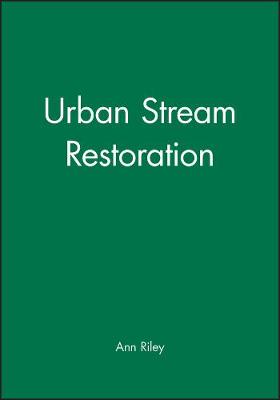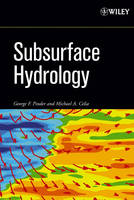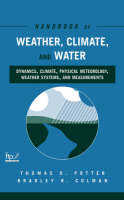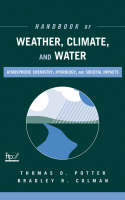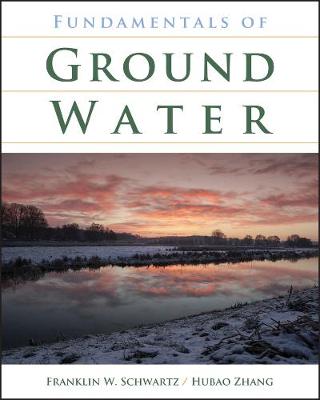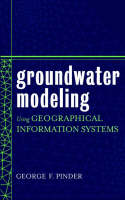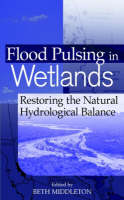Effective Groundwater Model Calibration
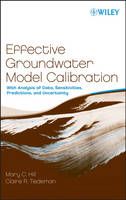 -15%
portes grátis
-15%
portes grátis
Effective Groundwater Model Calibration
With Analysis of Data, Sensitivities, Predictions, and Uncertainty
Tiedeman, Claire R.; Hill, Mary C.
John Wiley & Sons Inc
02/2007
480
Dura
Inglês
9780471776369
15 a 20 dias
816
1.1 Book and Associated Contributions: Methods, Guidelines, Exercises, Answers, Software, and PowerPoint Files.
1.2 Model Calibration with Inverse Modeling.
1.2.1 Parameterization.
1.2.2 Objective Function.
1.2.3 Utility of Inverse Modeling and Associated Methods.
1.2.4 Using the Model to Quantitatively Connect Parameters, Observations, and Predictions.
1.3 Relation of this Book to Other Ideas and Previous Works.
1.3.1 Predictive Versus Calibrated Models.
1.3.2 Previous Work.
1.4 A Few Definitions.
1.4.1 Linear and Nonlinear.
1.4.2 Precision, Accuracy, Reliability, and Uncertainty.
1.5 Advantageous Expertise and Suggested Readings.
1.6 Overview of Chapters 2 Through 15.
2 Computer Software and Groundwater Management Problem Used in the Exercises.
2.1 Computer Programs MODFLOW-2000, UCODE_2005, and PEST.
2.2 Groundwater Management Problem Used for the Exercises.
2.2.1 Purpose and Strategy.
2.2.2 Flow System Characteristics.
2.3 Exercises.
Exercise 2.1: Simulate Steady-State Heads and Perform Preparatory Steps.
3 Comparing Observed and Simulated Values Using Objective Functions.
3.1 Weighted Least-Squares Objective Function.
3.1.1 With a Diagonal Weight Matrix.
3.1.2 With a Full Weight Matrix.
3.2 Alternative Objective Functions.
3.2.1 Maximum-Likelihood Objective Function.
3.2.2 L1 Norm Objective Function.
3.2.3 Multiobjective Function.
3.3 Requirements for Accurate Simulated Results.
3.3.1 Accurate Model.
3.3.2 Unbiased Observations and Prior Information.
3.3.3 Weighting Reflects Errors.
3.4 Additional Issues.
3.4.1 Prior Information.
3.4.2 Weighting.
3.4.3 Residuals and Weighted Residuals.
3.5 Least-Squares Objective-Function Surfaces.
3.6 Exercises.
Exercise 3.1: Steady-State Parameter Definition.
Exercise 3.2: Observations for the Steady-State Problem.
Exercise 3.3: Evaluate Model Fit Using Starting Parameter Values.
4 Determining the Information that Observations Provide on Parameter Values using Fit-Independent Statistics.
4.1 Using Observations.
4.1.1 Model Construction and Parameter Definition.
4.1.2 Parameter Values.
4.2 When to Determine the Information that Observations Provide About Parameter Values.
4.3 Fit-Independent Statistics for Sensitivity Analysis.
4.3.1 Sensitivities.
4.3.2 Scaling.
4.3.3 Dimensionless Scaled Sensitivities (dss).
4.3.4 Composite Scaled Sensitivities (css).
4.3.5 Parameter Correlation Coefficients (pcc).
4.3.6 Leverage Statistics.
4.3.7 One-Percent Scaled Sensitivities.
4.4 Advantages and Limitations of Fit-Independent Statistics for Sensitivity Analysis.
4.4.1 Scaled Sensitivities.
4.4.2 Parameter Correlation Coefficients.
4.4.3 Leverage Statistics.
4.5 Exercises.
Exercise 4.1: Sensitivity Analysis for the Steady-State Model with Starting Parameter Values.
5 Estimating Parameter Values.
5.1 The Modified Gauss-Newton Gradient Method.
5.1.1 Normal Equations.
5.1.2 An Example.
5.1.3 Convergence Criteria.
5.2 Alternative Optimization Methods.
5.3 Multiobjective Optimization.
5.4 Log-Transformed Parameters.
5.5 Use of Limits on Estimated Parameter Values.
5.6 Exercises.
Exercise 5.1: Modified Gauss-Newton Method and Application to a Two-Parameter Problem.
Exercise 5.2: Estimate the Parameters of the Steady-State Model.
6 Evaluating Model Fit.
6.1 Magnitude of Residuals and Weighted Residuals.
6.2 Identify Systematic Misfit.
6.3 Measures of Overall Model Fit.
6.3.1 Objective-Function Value.
6.3.2 Calculated Error Variance and Standard Error.
6.3.3 AIC, AICc, and BIC Statistics.
6.4 Analyzing Model Fit Graphically and Related Statistics.
6.4.1 Using Graphical Analysis of Weighted Residuals to Detect Model Error.
6.4.2 Weighted Residuals Versus Weighted or Unweighted Simulated Values and Minimum, Maximum, and Average Weighted Residuals.
6.4.3 Weighted or Unweighted Observations Versus Simulated Values and Correlation Coefficient R.
6.4.4 Graphs and Maps Using Independent Variables and the Runs Statistic.
6.4.5 Normal Probability Graphs and Correlation Coefficient RN2.
6.4.6 Acceptable Deviations from Random, Normally Distributed Weighted Residuals.
6.5 Exercises.
Exercise 6.1: Statistical Measures of Overall Fit.
Exercise 6.2: Evaluate Graph Model fit and Related Statistics.
7 Evaluating Estimated Parameter Values and Parameter Uncertainty.
7.1 Reevaluating Composite Scaled Sensitivities.
7.2 Using Statistics from the Parameter Variance-Covariance Matrix.
7.2.1 Five Versions of the Variance-Covariance Matrix.
7.2.2 Parameter Variances, Covariances, Standard Deviations, Coefficients of Variation, and Correlation Coefficients.
7.2.3 Relation Between Sample and Regression Statistics.
7.2.4 Statistics for Log-Transformed Parameters.
7.2.5 When to Use the Five Versions of the Parameter Variance-Covariance Matrix.
7.2.6 Some Alternate Methods: Eigenvectors, Eigenvalues, and Singular Value Decomposition.
7.3 Identifying Observations Important to Estimated Parameter Values.
7.3.1 Leverage Statistics.
7.3.2 Influence Statistics.
7.4 Uniqueness and Optimality of the Estimated Parameter Values.
7.5 Quantifying Parameter Value Uncertainty.
7.5.1 Inferential Statistics.
7.5.2 Monte Carlo Methods.
7.6 Checking Parameter Estimates Against Reasonable Values.
7.7 Testing Linearity.
7.8 Exercises.
Exercise 7.1: Parameter Statistics.
Exercise 7.2: Consider All the Different Correlation Coefficients Presented.
Exercise 7.3: Test for Linearity.
8 Evaluating Model Predictions, Data Needs, and Prediction Uncertainty.
8.1 Simulating Predictions and Prediction Sensitivities and Standard Deviations.
8.2 Using Predictions to Guide Collection of Data that Directly Characterize System Properties.
8.2.1 Prediction Scaled Sensitivities (pss).
8.2.2 Prediction Scaled Sensitivities Used in Conjunction with Composite Scaled Sensitivities.
8.2.3 Parameter Correlation Coefficients without and with Predictions.
8.2.4 Composite and Prediction Scaled Sensitivities Used with Parameter Correlation Coefficients.
8.2.5 Parameter-Prediction ( ppr) Statistic.
8.3 Using Predictions to Guide Collection of Observation Data.
8.3.1 Use of Prediction, Composite, and Dimensionless Scaled Sensitivities and Parameter Correlation Coefficients.
8.3.2 Observation-Prediction (opr) Statistic.
8.3.3 Insights About the opr Statistic from Other Fit-Independent Statistics.
8.3.4 Implications for Monitoring Network Design.
8.4 Quantifying Prediction Uncertainty Using Inferential Statistics.
8.4.1 Definitions.
8.4.2 Linear Confidence and Prediction Intervals on Predictions.
8.4.3 Nonlinear Confidence and Prediction Intervals.
8.4.4 Using the Theis Example to Understand Linear and Nonlinear Confidence Intervals.
8.4.5 Differences and Their Standard Deviations, Confidence Intervals, and Prediction Intervals.
8.4.6 Using Confidence Intervals to Serve the Purposes of Traditional Sensitivity Analysis.
8.5 Quantifying Prediction Uncertainty Using Monte Carlo Analysis.
8.5.1 Elements of a Monte Carlo Analysis.
8.5.2 Relation Between Monte Carlo Analysis and Linear and Nonlinear Confidence Intervals.
8.5.3 Using the Theis Example to Understand Monte Carlo Methods.
8.6 Quantifying Prediction Uncertainty Using Alternative Models.
8.7 Testing Model Nonlinearity with Respect to the Predictions.
8.8 Exercises.
Exercise 8.1: Predict Advective Transport and Perform Sensitivity Analysis.
Exercise 8.2: Prediction Uncertainty Measured Using Inferential Statistics.
9 Calibrating Transient and Transport Models and Recalibrating Existing Models.
9.1 Strategies for Calibrating Transient Models.
9.1.1 Initial Conditions.
9.1.2 Transient Observations.
9.1.3 Additional Model Inputs.
9.2 Strategies for Calibrating Transport Models.
9.2.1 Selecting Processes to Include.
9.2.2 Defining Source Geometry and Concentrations.
9.2.3 Scale Issues.
9.2.4 Numerical Issues: Model Accuracy and Execution Time.
9.2.5 Transport Observations.
9.2.6 Additional Model Inputs.
9.2.7 Examples of Obtaining a Tractable, Useful Model.
9.3 Strategies for Recalibrating Existing Models.
9.4 Exercises (optional).
Exercises 9.1 and 9.2: Simulate Transient Hydraulic Heads and Perform Preparatory Steps.
Exercise 9.3: Transient Parameter Definition.
Exercise 9.4: Observations for the Transient Problem.
Exercise 9.5: Evaluate Transient Model Fit Using Starting Parameter Values.
Exercise 9.6: Sensitivity Analysis for the Initial Model.
Exercise 9.7: Estimate Parameters for the Transient System by Nonlinear Regression.
Exercise 9.8: Evaluate Measures of Model Fit.
Exercise 9.9: Perform Graphical Analyses of Model Fit and Evaluate Related Statistics.
Exercise 9.10: Evaluate Estimated Parameters.
Exercise 9.11: Test for Linearity.
Exercise 9.12: Predictions.
10 Guidelines for Effective Modeling.
10.1 Purpose of the Guidelines.
10.2 Relation to Previous Work.
10.3 Suggestions for Effective Implementation.
11 Guidelines 1 Through 8-Model Development.
Guideline 1: Apply the Principle of Parsimony.
G1.1 Problem.
G1.2 Constructive Approaches.
Guideline 2: Use a Broad Range of System Information to Constrain the Problem.
G2.1 Data Assimilation.
G2.2 Using System Information.
G2.3 Data Management.
G2.4 Application: Characterizing a Fractured Dolomite Aquifer.
Guideline 3: Maintain a Well-Posed, Comprehensive Regression Problem.
G3.1 Examples.
G3.2 Effects of Nonlinearity on the css and pcc.
Guideline 4: Include Many Kinds of Data as Observations in the Regression.
G4.1 Interpolated "Observations".
G4.2 Clustered Observations.
G4.3 Observations that Are Inconsistent with Model Construction.
G4.4 Applications: Using Different Types of Observations to Calibrate Groundwater Flow and Transport Models.
Guideline 5: Use Prior Information Carefully.
G5.1 Use of Prior Information Compared with Observations.
G5.2 Highly Parameterized Models.
G5.3 Applications: Geophysical Data.
Guideline 6: Assign Weights that Reflect Errors.
G6.1 Determine Weights.
G6.2 Issues of Weighting in Nonlinear Regression.
Guideline 7: Encourage Convergence by Making the Model More Accurate and Evaluating the Observations.
Guideline 8: Consider Alternative Models.
G8.1 Develop Alternative Models.
G8.2 Discriminate Between Models.
G8.3 Simulate Predictions with Alternative Models.
G8.4 Application.
12 Guidelines 9 and 10-Model Testing.
Guideline 9: Evaluate Model Fit.
G9.1 Determine Model Fit.
G9.2 Examine Fit for Existing Observations Important to the Purpose of the Model.
G9.3 Diagnose the Cause of Poor Model Fit.
Guideline 10: Evaluate Optimized Parameter Values.
G10.1 Quantify Parameter-Value Uncertainty.
G10.2 Use Parameter Estimates to Detect Model Error.
G10.3 Diagnose the Cause of Unreasonable Optimal Parameter Estimates.
G10.4 Identify Observations Important to the Parameter Estimates.
G10.5 Reduce or Increase the Number of Parameters.
13 Guidelines 11 and 12-Potential New Data.
Guideline 11: Identify New Data to Improve Simulated Processes, Features, and Properties.
Guideline 12: Identify New Data to Improve Predictions.
G12.1 Potential New Data to Improve Features and Properties Governing System Dynamics.
G12.2 Potential New Data to Support Observations.
14 Guidelines 13 and 14-Prediction Uncertainty.
Guideline 13: Evaluate Prediction Uncertainty and Accuracy Using Deterministic Methods.
G13.1 Use Regression to Determine Whether Predicted Values Are Contradicted by the Calibrated Model.
G13.2 Use Omitted Data and Postaudits.
Guideline 14: Quantify Prediction Uncertainty Using Statistical Methods.
G14.1 Inferential Statistics.
G14.2 Monte Carlo Methods.
15 Using and Testing the Methods and Guidelines.
15.1 Execution Time Issues.
15.2 Field Applications and Synthetic Test Cases.
15.2.1 The Death Valley Regional Flow System, California and Nevada, USA.
15.2.2 Grindsted Landfill, Denmark.
Appendix A: Objective Function Issues.
A.1 Derivation of the Maximum-Likelihood Objective Function.
A.2 Relation of the Maximum-Likelihood and Least-Squares Objective Functions.
A.3 Assumptions Required for Diagonal Weighting to be Correct.
A.4 References.
Appendix B: Calculation Details of the Modified Gauss-Newton Method.
B.1 Vectors and Matrices for Nonlinear Regression.
B.2 Quasi-Newton Updating of the Normal Equations.
B.3 Calculating the Damping Parameter.
B.4 Solving the Normal Equations.
B.5 References.
Appendix C: Two Important Properties of Linear Regression and the Effects of Nonlinearity.
C.1 Identities Needed for the Proofs.
C.1.1 True Linear Model.
C.1.2 True Nonlinear Model.
C.1.3 Linearized True Nonlinear Model.
C.1.4 Approximate Linear Model.
C.1.5 Approximate Nonlinear Model.
C.1.6 Linearized Approximate Nonlinear Model.
C.1.7 The Importance of X and X.
C.1.8 Considering Many Observations.
C.1.9 Normal Equations.
C.1.10 Random Variables.
C.1.11 Expected Value.
C.1.12 Variance-Covariance Matrix of a Vector.
C.2 Proof of Property 1: Parameters Estimated by Linear Regression are Unbiased.
C.3 Proof of Property 2: The Weight Matrix Needs to be Defined in a Particular Way for Eq. (7.1) to Apply and for the Parameter Estimates to have the Smallest Variance.
C.4 References.
Appendix D: Selected Statistical Tables.
D.1 References.
References.
Index.
1.1 Book and Associated Contributions: Methods, Guidelines, Exercises, Answers, Software, and PowerPoint Files.
1.2 Model Calibration with Inverse Modeling.
1.2.1 Parameterization.
1.2.2 Objective Function.
1.2.3 Utility of Inverse Modeling and Associated Methods.
1.2.4 Using the Model to Quantitatively Connect Parameters, Observations, and Predictions.
1.3 Relation of this Book to Other Ideas and Previous Works.
1.3.1 Predictive Versus Calibrated Models.
1.3.2 Previous Work.
1.4 A Few Definitions.
1.4.1 Linear and Nonlinear.
1.4.2 Precision, Accuracy, Reliability, and Uncertainty.
1.5 Advantageous Expertise and Suggested Readings.
1.6 Overview of Chapters 2 Through 15.
2 Computer Software and Groundwater Management Problem Used in the Exercises.
2.1 Computer Programs MODFLOW-2000, UCODE_2005, and PEST.
2.2 Groundwater Management Problem Used for the Exercises.
2.2.1 Purpose and Strategy.
2.2.2 Flow System Characteristics.
2.3 Exercises.
Exercise 2.1: Simulate Steady-State Heads and Perform Preparatory Steps.
3 Comparing Observed and Simulated Values Using Objective Functions.
3.1 Weighted Least-Squares Objective Function.
3.1.1 With a Diagonal Weight Matrix.
3.1.2 With a Full Weight Matrix.
3.2 Alternative Objective Functions.
3.2.1 Maximum-Likelihood Objective Function.
3.2.2 L1 Norm Objective Function.
3.2.3 Multiobjective Function.
3.3 Requirements for Accurate Simulated Results.
3.3.1 Accurate Model.
3.3.2 Unbiased Observations and Prior Information.
3.3.3 Weighting Reflects Errors.
3.4 Additional Issues.
3.4.1 Prior Information.
3.4.2 Weighting.
3.4.3 Residuals and Weighted Residuals.
3.5 Least-Squares Objective-Function Surfaces.
3.6 Exercises.
Exercise 3.1: Steady-State Parameter Definition.
Exercise 3.2: Observations for the Steady-State Problem.
Exercise 3.3: Evaluate Model Fit Using Starting Parameter Values.
4 Determining the Information that Observations Provide on Parameter Values using Fit-Independent Statistics.
4.1 Using Observations.
4.1.1 Model Construction and Parameter Definition.
4.1.2 Parameter Values.
4.2 When to Determine the Information that Observations Provide About Parameter Values.
4.3 Fit-Independent Statistics for Sensitivity Analysis.
4.3.1 Sensitivities.
4.3.2 Scaling.
4.3.3 Dimensionless Scaled Sensitivities (dss).
4.3.4 Composite Scaled Sensitivities (css).
4.3.5 Parameter Correlation Coefficients (pcc).
4.3.6 Leverage Statistics.
4.3.7 One-Percent Scaled Sensitivities.
4.4 Advantages and Limitations of Fit-Independent Statistics for Sensitivity Analysis.
4.4.1 Scaled Sensitivities.
4.4.2 Parameter Correlation Coefficients.
4.4.3 Leverage Statistics.
4.5 Exercises.
Exercise 4.1: Sensitivity Analysis for the Steady-State Model with Starting Parameter Values.
5 Estimating Parameter Values.
5.1 The Modified Gauss-Newton Gradient Method.
5.1.1 Normal Equations.
5.1.2 An Example.
5.1.3 Convergence Criteria.
5.2 Alternative Optimization Methods.
5.3 Multiobjective Optimization.
5.4 Log-Transformed Parameters.
5.5 Use of Limits on Estimated Parameter Values.
5.6 Exercises.
Exercise 5.1: Modified Gauss-Newton Method and Application to a Two-Parameter Problem.
Exercise 5.2: Estimate the Parameters of the Steady-State Model.
6 Evaluating Model Fit.
6.1 Magnitude of Residuals and Weighted Residuals.
6.2 Identify Systematic Misfit.
6.3 Measures of Overall Model Fit.
6.3.1 Objective-Function Value.
6.3.2 Calculated Error Variance and Standard Error.
6.3.3 AIC, AICc, and BIC Statistics.
6.4 Analyzing Model Fit Graphically and Related Statistics.
6.4.1 Using Graphical Analysis of Weighted Residuals to Detect Model Error.
6.4.2 Weighted Residuals Versus Weighted or Unweighted Simulated Values and Minimum, Maximum, and Average Weighted Residuals.
6.4.3 Weighted or Unweighted Observations Versus Simulated Values and Correlation Coefficient R.
6.4.4 Graphs and Maps Using Independent Variables and the Runs Statistic.
6.4.5 Normal Probability Graphs and Correlation Coefficient RN2.
6.4.6 Acceptable Deviations from Random, Normally Distributed Weighted Residuals.
6.5 Exercises.
Exercise 6.1: Statistical Measures of Overall Fit.
Exercise 6.2: Evaluate Graph Model fit and Related Statistics.
7 Evaluating Estimated Parameter Values and Parameter Uncertainty.
7.1 Reevaluating Composite Scaled Sensitivities.
7.2 Using Statistics from the Parameter Variance-Covariance Matrix.
7.2.1 Five Versions of the Variance-Covariance Matrix.
7.2.2 Parameter Variances, Covariances, Standard Deviations, Coefficients of Variation, and Correlation Coefficients.
7.2.3 Relation Between Sample and Regression Statistics.
7.2.4 Statistics for Log-Transformed Parameters.
7.2.5 When to Use the Five Versions of the Parameter Variance-Covariance Matrix.
7.2.6 Some Alternate Methods: Eigenvectors, Eigenvalues, and Singular Value Decomposition.
7.3 Identifying Observations Important to Estimated Parameter Values.
7.3.1 Leverage Statistics.
7.3.2 Influence Statistics.
7.4 Uniqueness and Optimality of the Estimated Parameter Values.
7.5 Quantifying Parameter Value Uncertainty.
7.5.1 Inferential Statistics.
7.5.2 Monte Carlo Methods.
7.6 Checking Parameter Estimates Against Reasonable Values.
7.7 Testing Linearity.
7.8 Exercises.
Exercise 7.1: Parameter Statistics.
Exercise 7.2: Consider All the Different Correlation Coefficients Presented.
Exercise 7.3: Test for Linearity.
8 Evaluating Model Predictions, Data Needs, and Prediction Uncertainty.
8.1 Simulating Predictions and Prediction Sensitivities and Standard Deviations.
8.2 Using Predictions to Guide Collection of Data that Directly Characterize System Properties.
8.2.1 Prediction Scaled Sensitivities (pss).
8.2.2 Prediction Scaled Sensitivities Used in Conjunction with Composite Scaled Sensitivities.
8.2.3 Parameter Correlation Coefficients without and with Predictions.
8.2.4 Composite and Prediction Scaled Sensitivities Used with Parameter Correlation Coefficients.
8.2.5 Parameter-Prediction ( ppr) Statistic.
8.3 Using Predictions to Guide Collection of Observation Data.
8.3.1 Use of Prediction, Composite, and Dimensionless Scaled Sensitivities and Parameter Correlation Coefficients.
8.3.2 Observation-Prediction (opr) Statistic.
8.3.3 Insights About the opr Statistic from Other Fit-Independent Statistics.
8.3.4 Implications for Monitoring Network Design.
8.4 Quantifying Prediction Uncertainty Using Inferential Statistics.
8.4.1 Definitions.
8.4.2 Linear Confidence and Prediction Intervals on Predictions.
8.4.3 Nonlinear Confidence and Prediction Intervals.
8.4.4 Using the Theis Example to Understand Linear and Nonlinear Confidence Intervals.
8.4.5 Differences and Their Standard Deviations, Confidence Intervals, and Prediction Intervals.
8.4.6 Using Confidence Intervals to Serve the Purposes of Traditional Sensitivity Analysis.
8.5 Quantifying Prediction Uncertainty Using Monte Carlo Analysis.
8.5.1 Elements of a Monte Carlo Analysis.
8.5.2 Relation Between Monte Carlo Analysis and Linear and Nonlinear Confidence Intervals.
8.5.3 Using the Theis Example to Understand Monte Carlo Methods.
8.6 Quantifying Prediction Uncertainty Using Alternative Models.
8.7 Testing Model Nonlinearity with Respect to the Predictions.
8.8 Exercises.
Exercise 8.1: Predict Advective Transport and Perform Sensitivity Analysis.
Exercise 8.2: Prediction Uncertainty Measured Using Inferential Statistics.
9 Calibrating Transient and Transport Models and Recalibrating Existing Models.
9.1 Strategies for Calibrating Transient Models.
9.1.1 Initial Conditions.
9.1.2 Transient Observations.
9.1.3 Additional Model Inputs.
9.2 Strategies for Calibrating Transport Models.
9.2.1 Selecting Processes to Include.
9.2.2 Defining Source Geometry and Concentrations.
9.2.3 Scale Issues.
9.2.4 Numerical Issues: Model Accuracy and Execution Time.
9.2.5 Transport Observations.
9.2.6 Additional Model Inputs.
9.2.7 Examples of Obtaining a Tractable, Useful Model.
9.3 Strategies for Recalibrating Existing Models.
9.4 Exercises (optional).
Exercises 9.1 and 9.2: Simulate Transient Hydraulic Heads and Perform Preparatory Steps.
Exercise 9.3: Transient Parameter Definition.
Exercise 9.4: Observations for the Transient Problem.
Exercise 9.5: Evaluate Transient Model Fit Using Starting Parameter Values.
Exercise 9.6: Sensitivity Analysis for the Initial Model.
Exercise 9.7: Estimate Parameters for the Transient System by Nonlinear Regression.
Exercise 9.8: Evaluate Measures of Model Fit.
Exercise 9.9: Perform Graphical Analyses of Model Fit and Evaluate Related Statistics.
Exercise 9.10: Evaluate Estimated Parameters.
Exercise 9.11: Test for Linearity.
Exercise 9.12: Predictions.
10 Guidelines for Effective Modeling.
10.1 Purpose of the Guidelines.
10.2 Relation to Previous Work.
10.3 Suggestions for Effective Implementation.
11 Guidelines 1 Through 8-Model Development.
Guideline 1: Apply the Principle of Parsimony.
G1.1 Problem.
G1.2 Constructive Approaches.
Guideline 2: Use a Broad Range of System Information to Constrain the Problem.
G2.1 Data Assimilation.
G2.2 Using System Information.
G2.3 Data Management.
G2.4 Application: Characterizing a Fractured Dolomite Aquifer.
Guideline 3: Maintain a Well-Posed, Comprehensive Regression Problem.
G3.1 Examples.
G3.2 Effects of Nonlinearity on the css and pcc.
Guideline 4: Include Many Kinds of Data as Observations in the Regression.
G4.1 Interpolated "Observations".
G4.2 Clustered Observations.
G4.3 Observations that Are Inconsistent with Model Construction.
G4.4 Applications: Using Different Types of Observations to Calibrate Groundwater Flow and Transport Models.
Guideline 5: Use Prior Information Carefully.
G5.1 Use of Prior Information Compared with Observations.
G5.2 Highly Parameterized Models.
G5.3 Applications: Geophysical Data.
Guideline 6: Assign Weights that Reflect Errors.
G6.1 Determine Weights.
G6.2 Issues of Weighting in Nonlinear Regression.
Guideline 7: Encourage Convergence by Making the Model More Accurate and Evaluating the Observations.
Guideline 8: Consider Alternative Models.
G8.1 Develop Alternative Models.
G8.2 Discriminate Between Models.
G8.3 Simulate Predictions with Alternative Models.
G8.4 Application.
12 Guidelines 9 and 10-Model Testing.
Guideline 9: Evaluate Model Fit.
G9.1 Determine Model Fit.
G9.2 Examine Fit for Existing Observations Important to the Purpose of the Model.
G9.3 Diagnose the Cause of Poor Model Fit.
Guideline 10: Evaluate Optimized Parameter Values.
G10.1 Quantify Parameter-Value Uncertainty.
G10.2 Use Parameter Estimates to Detect Model Error.
G10.3 Diagnose the Cause of Unreasonable Optimal Parameter Estimates.
G10.4 Identify Observations Important to the Parameter Estimates.
G10.5 Reduce or Increase the Number of Parameters.
13 Guidelines 11 and 12-Potential New Data.
Guideline 11: Identify New Data to Improve Simulated Processes, Features, and Properties.
Guideline 12: Identify New Data to Improve Predictions.
G12.1 Potential New Data to Improve Features and Properties Governing System Dynamics.
G12.2 Potential New Data to Support Observations.
14 Guidelines 13 and 14-Prediction Uncertainty.
Guideline 13: Evaluate Prediction Uncertainty and Accuracy Using Deterministic Methods.
G13.1 Use Regression to Determine Whether Predicted Values Are Contradicted by the Calibrated Model.
G13.2 Use Omitted Data and Postaudits.
Guideline 14: Quantify Prediction Uncertainty Using Statistical Methods.
G14.1 Inferential Statistics.
G14.2 Monte Carlo Methods.
15 Using and Testing the Methods and Guidelines.
15.1 Execution Time Issues.
15.2 Field Applications and Synthetic Test Cases.
15.2.1 The Death Valley Regional Flow System, California and Nevada, USA.
15.2.2 Grindsted Landfill, Denmark.
Appendix A: Objective Function Issues.
A.1 Derivation of the Maximum-Likelihood Objective Function.
A.2 Relation of the Maximum-Likelihood and Least-Squares Objective Functions.
A.3 Assumptions Required for Diagonal Weighting to be Correct.
A.4 References.
Appendix B: Calculation Details of the Modified Gauss-Newton Method.
B.1 Vectors and Matrices for Nonlinear Regression.
B.2 Quasi-Newton Updating of the Normal Equations.
B.3 Calculating the Damping Parameter.
B.4 Solving the Normal Equations.
B.5 References.
Appendix C: Two Important Properties of Linear Regression and the Effects of Nonlinearity.
C.1 Identities Needed for the Proofs.
C.1.1 True Linear Model.
C.1.2 True Nonlinear Model.
C.1.3 Linearized True Nonlinear Model.
C.1.4 Approximate Linear Model.
C.1.5 Approximate Nonlinear Model.
C.1.6 Linearized Approximate Nonlinear Model.
C.1.7 The Importance of X and X.
C.1.8 Considering Many Observations.
C.1.9 Normal Equations.
C.1.10 Random Variables.
C.1.11 Expected Value.
C.1.12 Variance-Covariance Matrix of a Vector.
C.2 Proof of Property 1: Parameters Estimated by Linear Regression are Unbiased.
C.3 Proof of Property 2: The Weight Matrix Needs to be Defined in a Particular Way for Eq. (7.1) to Apply and for the Parameter Estimates to have the Smallest Variance.
C.4 References.
Appendix D: Selected Statistical Tables.
D.1 References.
References.
Index.

